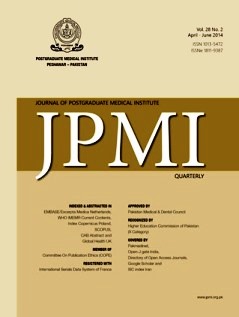Frequency of common bacteria and their antibiotic sensitivity in patients with symptomatic cholelithiasis
Main Article Content
Abstract
Objective: To determine the frequency of common bacteria and their antibioticsensitivity in patients with symptomatic cholelithiasisMethodology: This cross sectional descriptive study was conducted at Departmentof Surgery, Lady reading hospital, Peshawar for 6 months i.e., fromDecember 2012 to May 2013. The total number of patients were 126. Theypresented with symptomatic cholelithiasis. Bile was aspirated peroperativelybefore cholecystectomy from gall bladder and was sent for culture and sensitivitytest. The data was analyzed using Statistical Package for Social Sciences(SPSS) version 10.0.Results: On culture and sensitivity test, 74 (58.73%) have positive growthwhile 52 (41.27%) have no growth. The most common bacteria was E. Coli isolatedin 28 (22.22%) patients followed by Klebseilla in 22 (17.46%), Salmonellain 16 (12.70%) and Shigella in 8 (6.35%) patients. On culture and sensitivitytest, all the 4 isolated bacteria showed sensitivity to Cefuroxime, Ceftriaxoneand Ciprofloxacin in more than 50 % cases, while all the four bacteria showedresistance to amoxicillin in more than 50 % cases.Conclusion: The most common bacteria of symptomatic cholelithiasis areE. coli and Klebseilla followed by Salmonella and Shigella. These bacteriashowed maximum sensitive to cefuroxime and ceftriaxone.
Article Details
How to Cite
1.
Manan F, Khan MA, Faraz A, Khan M. Frequency of common bacteria and their antibiotic sensitivity in patients with symptomatic cholelithiasis. J Postgrad Med Inst [Internet]. 2014 Apr. 17 [cited 2025 Dec. 13];28(2). Available from: https://jpmi.org.pk/index.php/jpmi/article/view/1554
Issue
Section
Original Article
Work published in JPMI is licensed under a
Creative Commons Attribution-NonCommercial 2.0 Generic License.
Authors are permitted and encouraged to post their work online (e.g., in institutional repositories or on their website) prior to and during the submission process, as it can lead to productive exchanges, as well as earlier and greater citation of published work.


